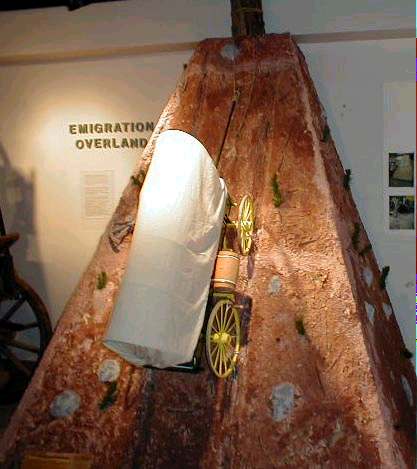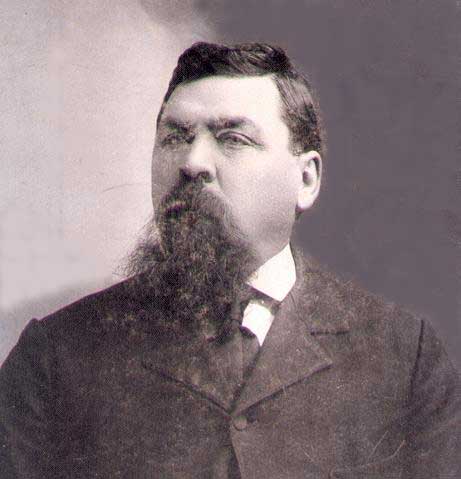 Churches of Christ & Christian Churches in the Pacific Northwest CLACKAMAS COUNTY, OREGON |
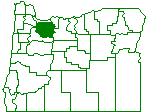
Sept. 16, 2003 |
Barlow |
Beaver Creek |
Canby |
Carver |
Cherryville
Currinsville |
Damascus |
Estacada |
Gladstone |
Molalla
Next Chapter . . .
Pioneer Menu . . .
Search
- - Presented by age:
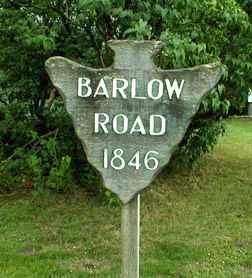
Beginning in 1846, three of every four pioneers entering the Willamette Valley used the Barlow Toll Road around Mt. Hood to avoid the treacherous rapids on the Columbia.
Sam Kimbrough Barlow hired a crew and cleared the road for travelers, although most did not appreciate his contribution to Oregon's growth. The presence of the toll was the big irritant to the immigrants.
The toll gate for tourists to see is beside Highway 26, near Government Camp. Barlow was a man of uncollected wealth when he died. Cash-poor overlanders signed IOUs, promising to pay the toll later, but many never did.
Evelyn Greenstreet gives the background for the Barlow Road.
The Barlow Road was eventually given to the State of Oregon. It is now incorporated in part in US 26.
Judge Matthew P Deady, an esteemed citizen and noted jurist of Oregon, is reported to have said of this road:
The construction of the Barlow Road contributed more towards the prosperity of the Willamette Valley and the future State of Oregon, than any other achievement prior to the building of the railways in 1870.It was also important to the development of the Stone/Campbell Movement churches. At one point the Churches of Christ and Christian Churches may have been the most numerous of any religious group in Oregon Territory.
The Road's infamous Laurel Hill chute was dangerous. The hardy visitor can see the 60% grade that many of his brethren faced by parking at the trail head and climbing the one-half mile of steps to the top of the chute. This climb is not for the faint-of-heart. The parking location is two miles west of Government Camp on Highway 26.
The Clackamas County Museum has constructed a display showing the incline, a wagon and the winching system at the top of the photo. The photo is large and may take a while to download.Carver Mapquest
The first three congregations were established in Oregon in 1846, but the location of the one "on the Clackamas" established by John Foster has been a mystery.

John was born in South Carolina in 1792 and had moved to Scott County, Kentucky by 1814 where he was married. Scott County was very close to Barton Warren Stone. John and Nancy had eight children between 1816 and 1833.
Researcher Donna M. Wojcik writes that John Foster (undoubtedly son John T.) was shot coming overland when a fellow-traveler accidently knocked over his gun.
"The ball passed through the fleshy part of his back and came out about three inches from where it had entered while a small fragment lodged in his arm."This happened June 8, 1845.
The Brazen Overlanders of 1845 by Donna M. Wojcik.
A 100 year old document published in the The Christian Standard confuses John Foster, the preacher, with Philip Foster, the merchant. They lived across the river from each other, but were not related. Philip Foster was from Augusta, Maine and arrived by sea in 1842. Foster Road in Portland bears his name. Through the research of surveyor Steve Buckles, we know that John Foster's 640 acres were across the Clackamas River from Carver, Oregon and about three miles east on Baker Ferry Road. At least two of John and Nancy's sons had property there, too. Foster Creek Lane is on the property and Foster Creek cuts through it. The Creek shows clearly on the Yahoo map.
Tranquility Lane, about 40 feet south of Foster Lane, takes the curious down to a lower level parallel with the river. The little flat is about 800 feet wide and .4 mile long. Many opulent hide-away-homes are there. It is reasonable that John Foster (1792-1868) chose this location for his log cabin in 1845. Indeed, he would have been "on the Clackamas."
The original 1846 route of the Barlow Road crossed John Foster's property after leaving the well-known Philip Foster Farm. (Later, an alternate route passed to the west of John's property. ) John had arrived the year before, staked out his claim and built a home. In the 1846 migration was Dr. James McBride and his large family and without a doubt, they got acquainted with John Foster at this time. In a few months, James McBride and Glen Owen Burnett returned to hold a gospel meeting in John's neighborhood.
The Oregon Intrepretive Center discusses the Philip Foster Farm. We have written profiles of Dr. James McBride and Glen Owen Burnett.(The pioneer name for Carver was Stone. We know for certain the church near the Foster property was called the Stone Church and the church was there before the town.)
The church probably included John Foster and Nancy, their sons Isaac M. Foster and his wife Letha Jane and Ambrose Foster and his wife Zerrelda and John T. Foster and his wife Adaline, John Sr.'s son-in-law Solomon Wheeler and his wife Melissa Elizabeth (John's daughter), plus the children of the families. All of these pioneers can be located among the travelers of 1845.
Stephenie Flora lists the overland pioneers of 1845.
John T. and Adaline are listed among the 1856 charter members of the Mill Creek Church in Marion County. Some records spell her name Adeline.
Very soon William and Millie Arthur, neighbors adjoining Solomon and Melissa on the west, were baptized into Christ. They were the parents of Mahala Cozine who would soon be baptized in Yamhill County. The Arthurs are listed among the travelers of 1843.
Stephenie Flora tells the story of the 1843 emigration and lists the overland pioneers including the Arthurs.While there is evidence that other congregations of the Stone/Campbell Movement were established in Clackamas County, there is no record of John Foster, Sr. preaching elsewhere in Oregon. John Foster was postmaster at Clackemas (rather than Clackamas), a post office on, or very close to, the properties of the Foster clan. It was closed in 1853.
C.F. Swander claims the Eagle Creek Christian Church began in 1891 or before. That location is close, but across the river from the John Foster location. It is possible that some of the group meeting on the John Foster property began meeting in Eagle Creek after the Baker Ferry was opened in 1872.
Historian Charles Addleman says, "After the death of John Foster, the church ceased to exist."
Unanswered question: Where was the church building located?
Pioneer Reminders: Foster Creek, Foster Creek Lane.Rock Creek
The building was located near Molalla on S. Wilhoit Road at its intersection with S. Dart Road.The Geographic Names Information Service of the U.S. Geological Survey list 89 streams call Rock Creek in Oregon. An early congregation in Clackamas County was the Rock Creek Church, two miles south of Molalla. Charles Bisby Dart and Isabella Dart had come from Indiana in 1852, and church meetings may have been held earlier under the leadership of Daniel Trullinger.
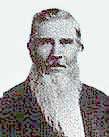
C. B. Dart The Oregon Intrepretive Center discusses the greater Trullinger family and their impact on Oregon.
Other pioneer members of the Rock Creek Church included Charles and Arena Dart (1852), Edward and Alice Rich Dart (1856), Levi and Matilda Davis (1853), Thomas and Parmelia Ann Garrett (1852), Charles and Lusena Hardesty (1852), Joseph and Polly Quinn (1852), Daniel and Elizabeth Trullinger (1848), Ann Vickers (1845), Elijah and Margaret Ann Weddle (1853). Elizabeth Johnson Trullinger was a niece of Andrew Johnson, the president that filled out the term of Abraham Lincoln.
The Rock Creek congregation ceased at its original location before the turn of the century. O. J. Russell says in his booklet The Church in Oregon:
A record book dating from 1863 gives the names of the members of the Upper Rock Creek Church of Christ located south of Molalla. The book was written by Charles Bisby Dart (1820-1902 ) . . . .
Later Russell says,
The very last entry in the Rock Creek Church record book significantly reads: "4th Lord's Day in 1900, November, a division sprang up in the congregation."
Marlin Love remembers the ancient church building very close to the intersection of Wilhoit and Dart. It was later moved a ways down Dart. All that remains of the building at the original site is the well used by the church. This is a fitting remembrance for a church that gave the Water of Life freely to all who came.
Marlin Love's father, James Love (1852-1927), once preached at the Rock Creek Church. Other preachers were Keathley Bailes in 1867 and a Brother Macher in 1869.
Pioneer Reminders: Dart Road.
Barlow Mapquest
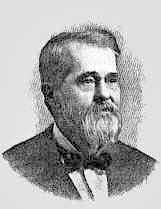
|
Stephenie Flora lists the overland pioneers of 1845 including William Barlow.
Barlow's father Samuel was the developer of the toll-road around Mt. Hood. William had worked as a toll taker for two seasons. That's where, in 1847, he met Rachel Larkins, his bride-to-be.
Evelyn Greenstreet gives the background for the Barlow Road.
They married, but Rachel died in 1848 and Dr. James McBride handled the funeral. This introduced the famous Barlow to the claims of Christ.
There is a profile of Dr. McBride.Glen Owen Burnett and John Ecles Murphy baptized William and Martha Ann (Partlow), his second wife, in 1855, along with a few others. In July of that year, A. V. McCarty held a Gospel Meeting in their spacious residence and six more were added to the tiny body of believers. McCarty returned in a month and yet six more were added.
From this small beginning the church was able to purchase a building that had been owned by another group. Over time, it was best for the Christian Church to merge with the nearby Canby Christian Church. The property was turned over to others.
It still stands at Second Maple Streets. It is now the Barlow Community Church.
William Barlow's house is on National Register of Historic Places. An 1885 photo can be seen on this link. Note the deer in the front yard. Tours are available.A photo exists of the believers dated 1926. There are seventy plus people in the picture, including children.
There is a profile of Glen Owen Burnett.
There is one of A. V. McCarty.
There is a profile of John E. Murphy.
The building was in place by 1892. The interior walls are of embossed metal, painted white. They are in perfect condition after more than 100 years. We asked Lee Johnson of Reyman Brothers Construction Company, restorers of classic buildings, about the material. He said,
I would guess that it is a product generally known as "tin ceiling". This product was designed to replicate the look of ornate plaster work and was generally used on ceilings, however it could have been used on walls also. It was very popular in the late nineteenth century and was used mostly in commercial applications.
Reyman Brothers Construction Company has its own web site.
Some of the original pews are still in place with their intricately carved ends.
Our thanks to local church historian Sue Barnett for tracing the ownership of the property for us.
Pioneer Reminders: The town's name.
Damascus Mapquest
The Damascus Church gave 1856 as their beginning date. In their 1881 report, they listed James Henry Pedigo and F. Lemmon as elders and a membership of 60. It was J. H. Pedigo's father, Edward, that selected the name for Damascus, a Biblical name.
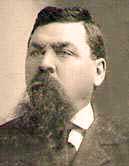
|
Corina Kusch Click for a larger version. |
Later, George P. Rich was the circuit-riding preacher. The church owned property listed at $600, so they had their own building. (That was a common and reasonable value for a church building in that era.) In 1889, George P. Rich is still listed as the minister of the church by the Business Directory published by R. L. Polk in Portland.
We have a profile of George P. Rich.A sampling of the times is found in a report to the Christian Messenger, published in Monmouth, Oregon. It reads,
Damascus, Or. July 20, 1877
On the fourth Sunday in last month, after an able discourse delivered by Bro. Rich, an invitation was extended, and one young lady came forward and confessed her Savior; and on the second Sunday in this month, in the presence of a large assembly of people, Bro. Rich immersed her into the body of Christ. May God bless her that she may hold out faithful.Bro. K. Bailes was with us on the 11th and 12th in this month and presented four discourses. The brethren were edified and we hope much good seed was sown.
(Signed) A Disciple
|
Early pioneer members (and their overland year) included:
Thomas and Luvena Bohna (1866),
David H. and Lucinda Deardorff (1852),
John M. and Rachel Deardorff (1852),
John S. and Dolly Pedigo Fisher (1854),
Samuel P. and Betsy Ann Pedigo Gilliland (1854),
Albert and Mary Ann Osborn (1865),
Edward and Lattice Pedigo (1854), and
James Henry and Martha Ann Foster Pedigo (1854 & 1845). |
One historical source says the church building (perhaps known also as the Pedigo Meeting House) stood near Sunnyside Road and was eventually destroyed by fire. Another early source says the Christian Church building was on the Curtis Young Land claim ( correction deed,1877 ).
Oregon City Mapquest
There are now several congregations in Oregon City with a background in the Stone/Campbell Restoration, but none of these are directly descended from the group of worshippers that dates to 1868. Pioneer preacher John M. Harris wrote to the Christian Record in May of that year describing the beginning at Oregon City:
From Portland, we came to Oregon City and preached five discourses, and organized a congregation with some sixteen members, with two added from the Baptists. The prospect for the cause in this place is good. Oregon City is one of the most romantic places I ever saw. It is situated at the great falls of the Willamette River, and is surrounded with the most beautiful mountain scenery on both sides of that great river.
In 1871 they reported 14 members when they were listed by the Christian Messenger, published in Monmouth, Oregon.
It is possible that Samuel and Elizabeth Markham, overlanders of 1847, were a part of this congregation. Their son, Charles Edwin Markham, was born in Oregon City on April 23, 1852 and was baptized into Christ as a teenager before enrolling in Christian College in Santa Rosa, California. He became "the Dean of American Poets."
Disciple historian Clarence Swander says under his 1893 listings,
Oregon City, in Clackamas county. This congregation did not survive. This was one of the hard places in the state to get a foothold. Time and time again the effort was made only to be defeated.Swander must not have known of the earlier group that reported to the Christian Messenger.
Beaver Creek Mapquest
This area south of Oregon City is named after a creek that flows through the community. The Christian Church there reported their date of organization as 1878. By 1880 they had 39 members. J. L. Wigle was the circuit-riding preacher in 1881.
Molalla Mapquest
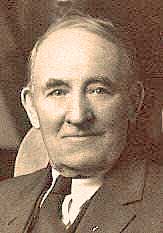
|
Photo courtesy of Burl Shoemake |
Another prominent member was Albert Taylor Shoemake (pictured at right, grandfather of Burl Shoemake of Sutter Creek, CA). A.T. was on the first city council of Molalla. Albert Shoemake (ca.1847-) eventually left to start the congregation at 7th and Evelyn in Grants Pass, Oregon.
1891 was the first date the Christian Church in Molalla reported their presence to the Disciples' state organization.
Cherryville Mapquest
Wild cherries once grew profusely in this rain-forest-like area, hence the name of the town. Property was purchased in 1891 for the Cherryville Christian Church. This area is located six miles east of Sandy and north of Highway 26. There is a cemetery on the old church property with markers dating to 1886. Legal witnesses to the purchase were Herman Bruns and Lena Bruns.
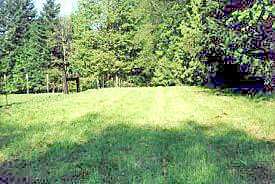
|
The cemetery is in the trees at the right of the photo. Not all land owners have kept the right-of-way cleared. |
One writer graphically described the cemetery as "neglected and forlorn amidst an aging grove of gnarled maple, hemlock and fir. Tumbled and broken headstones bear mute witness to the ravages of time and weather, and graves have been violated by burrowing animals and roots of invading vegetation."The 1891 date coincides with a letter written by D. W. Parker of Cherryville to the Octographic Review. Mr. Parker reports on a gospel meeting held there by George P. Rich who came to Oregon in 1875 with his wife and children. They had lived in Kansas and settled in Kelso, west of Cherryville.
We have a profile of George P. Rich.
The church building was constructed because it was reported in the 1889-1890 Business Directory published by R. L. Polk & Co. in Portland, Oregon. Of Cherryville it says,
Population 35. It has a Christian Church, and 27 children in school district.
Several other early documents mention the church in Cherryville but did not give its name.
The church and cemetery were located adjacent to the Barlow Road right-of-way. The cemetery is located on private property at 52225 Cherryville Drive. (Cherryville Drive was the first replacement for the Barlow Road, several hundred feet to the north.) The church building is gone and has been replaced by a prefab house.
Currinsville Mapquest
Dr. Swander reports the Currinsville Church was launched in 1891. The town was located on Highway 224 four miles north of Estacada. The 1892 Disciples Year Book shows there were eight members and the contact person was Frank Lemon. Since the group was so small and no property value is listed, it is doubtful if they had a building of their own. It is thought that the group was later absorbed by the Estacada Church.
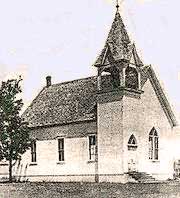 |
Clackamas Co. Historical |
The building shows on a 1913 map at 4th and B Streets, although that does not match the current street name scheme. Because the town is layed out at an angle, it was in the north corner of the intersection.
In those early days, the church struggled financially. Times were such that food and housing were plentiful, but money itself was scarce. Barter is seldom suitable for supporting the Lord's cause.
Estacada Mapquest
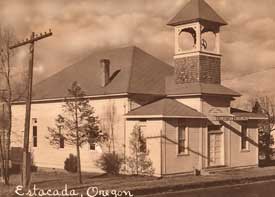
|
The building was located at 191 NE Pierce -- the corner of Pierce and 2nd. It appears to have begun as a simple structure with an addition later. The addition speaks of a growing congregation.
Harvey Cross selected the name of this developing town because he admired Prime Minister William E. Gladstone of England.
Established by Aaron Hayes Mulkey, the Gladstone Church of Christ was the first church of any kind in Gladstone. Originally meeting early in 1908 as a Sunday School, it was organized as a church in July of that same year with 55 members.
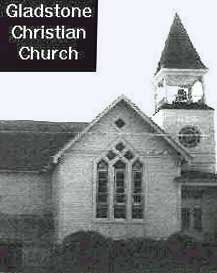
The first building was made of rough lumber without windows or floors and the benches were without backs. The next building, pictured, was erected in 1909 on lots that were donated by the late Judge Harvey Cross. The Italianate style home of Judge Cross is listed with the National Register of Historic Places. The Gladstone Christian Church now has a modern facility.
Others pioneer congregations included Concord and Oregon City.To DOCHS 2/02
Next Chapter: The Coastal Towns or back to Pioneer Menu

